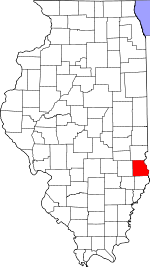In the Illinois territory during the War of 1812, there was a brief engagement between a group of United States Rangers and Native Americans called the Battle of Africa Point. [1] [2]
On April 18, 1813, during the fortification phase of Fort LaMotte, two barrel coopers Isaac Brimberry and Thomas Kennedy went up 'Africa Point', a knoll surrounded by swamp on the Wabash River, to procure some wood. They came across Indian canoes pulled on the shore of the river. Both Brimberry and Kennedy reported their sightings to the Fort LaMotte commander, Captain Pierce Andrews. [3]
Andrews sent up a squad of skirmishers with the timber party to look after the Indians. The rangers divided themselves into two groups, a six-man party going in advance while the other stayed back and acted as a reserve. On 'Africa Point' the advance group was ambushed and fired upon by the Kickapoo Indians. During the ensuing battle, the American party retreated suffering 4 dead and the 2 badly wounded who escaped back to the fort. [4] Upon hearing rifle fire, the rear guard fell back to the fort as well. The Indians had 5 killed. [5]

The War of 1812 was fought by the United States and its allies against the United Kingdom and its allies in North America. It began when the United States declared war on Britain on 18 June 1812. Although peace terms were agreed upon in the December 1814 Treaty of Ghent, the war did not officially end until the peace treaty was ratified by the United States Congress on 17 February 1815.
The Battle of York was a War of 1812 battle fought in York, Upper Canada on April 27, 1813. An American force, supported by a naval flotilla, landed on the western lakeshore and captured the provincial capital after defeating an outnumbered force of regulars, militia and Ojibwe natives under the command of Major General Roger Hale Sheaffe, the Lieutenant Governor of Upper Canada.

Fort Harrison was a War of 1812 era stockade constructed in Oct. 1811 on high ground overlooking the Wabash River on a portion of what is today the modern city of Terre Haute, Indiana, by forces under command of Gen. William Henry Harrison. It was a staging point for Harrison to encamp his forces just prior to the Battle of Tippecanoe a month later. The fort was the site of a famous battle in the War of 1812, the siege of Fort Harrison in Sept. 1812 that was the first significant victory for the U.S. in the war. The fort was abandoned in 1818 as the frontier moved westward.
The Battle of Longwoods took place during the Anglo-American War of 1812. On 4 March 1814, a mounted American raiding party defeated an attempt by British regulars, volunteers from the Canadian militia and Native Americans to intercept them near Wardsville, in present-day Southwest Middlesex, Ontario.
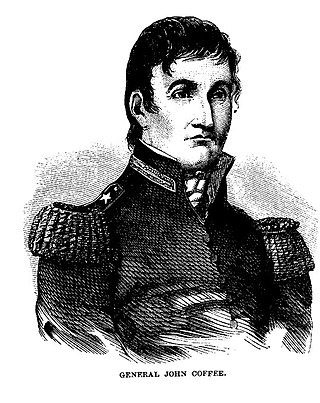
John R. Coffee was an American planter of English descent, and a state militia brigadier general in Tennessee. He commanded troops under General Andrew Jackson during the Creek Wars (1813–14) and during the Battle of New Orleans in the War of 1812.

Stephen Augustus Hurlbut was an attorney and politician, who commanded the U.S. Army of the Gulf in the American Civil War. Afterward, he continued to serve as a politician and also as a diplomat.

John Tipton was from Tennessee and became a farmer in Indiana; an officer in the 1811 Battle of Tippecanoe, and veteran officer of the War of 1812, in which he reached the rank of Brigadier General; and politician. He was elected to the Indiana General Assembly in 1819, and in 1831 as US Senator from the state of Indiana, serving until 1838. He was appointed as US Indian Agent and was selected to lead the militia in removing Menominee's band of Potawatomie in 1838; they were relocated to Kansas, Indian Territory.
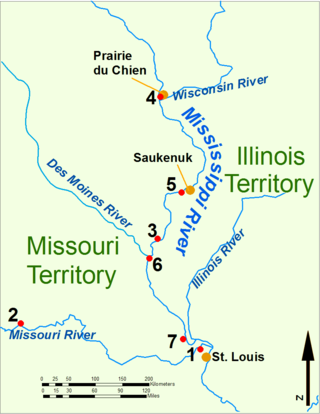
During the War of 1812, the Illinois Territory was the scene of fighting between Native Americans and United States soldiers and settlers. The Illinois Territory at that time included the areas of modern Illinois, Wisconsin and parts of Minnesota and Michigan.

Augustin Mottin de La Balme was a French cavalry officer who served in Europe during the Seven Years' War and in the United States during the American Revolution. His attempt to capture Fort Detroit in 1780 ended in defeat when he was ambushed by forces under Chief Little Turtle.

The Spafford Farm massacre, also referred to as the Wayne massacre, was an attack upon U.S. militia and civilians that occurred as part of the Black Hawk War near present-day South Wayne, Wisconsin. Spafford Farm was settled in 1830 by Omri Spafford and his partner Francis Spencer.

Benjamin Howard was a congressman from Kentucky, the first governor of the Missouri Territory and a brigadier general in the War of 1812.
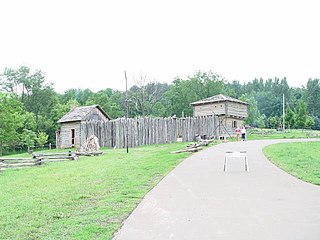
The Battle of Apple River Fort, occurred on the late afternoon of June 24, 1832 at the Apple River Fort, near present-day Elizabeth, Illinois, when Black Hawk and 200 of his "British Band" of Sauk and Fox were surprised by a group of four messengers en route from Galena, Illinois. One of the couriers was wounded in the thigh as the riders quickly made for the protection of the nearby stockade. Courier Fred Dixon lagged behind and provided cover for his comrades. The other couriers rode ahead to warn some 70 settlers of the approaching Sauk and Fox, thus saving their lives. The small company of militia at the fort, about 28-30 men and boys led by Captain Clack Stone, fought off Black Hawk's 150-man war party in an action that lasted about an hour. The withering pace of the gunfire eventually convinced Black Hawk that the fort was too heavily defended to lead a direct attack. He considered burning the fort, then switched to raiding cabins of foodstuffs, clothing and cooking utensils. In the gathering darkness, Black Hawk and his war party retreated.

Shabbona or Shab-eh-nay, sometimes referred to as Shabonee and Shaubena, was an Ottawa tribe member who became a chief within the Potawatomi tribe in Illinois during the 19th century.
Fort Lamotte was a fort created between 1810 and 1812 by Baptists near Palestine, Illinois. It was the site of the Battle of Africa Point in the War of 1812, one of few battles of the war in the Illinois Territory. During the War of 1812 there were 26 families living in Fort LaMotte, and 90 rangers under the command of frontier officer Captain Pierce Andrews. It was in use through 1817 and is currently being recreated. The inhabitants of the Fort became the nucleus of Palestine. Fort Foot served as an expansion of and partial replacement for Fort Lamotte.
The Indiana Rangers, also known as the Indiana Territorial Mounted Rangers, were a mounted militia formed in 1807 and operated in the early part of the 19th century to defend settlers in Indiana Territory from attacks by Native Americans. The rangers were present at the Battle of Tippecanoe, and served as auxiliaries to the army during the War of 1812. At the peak of their activities they numbered over 400 men.

The Battle of Rock Island Rapids, also called the Battle of Campbell Island, was an American defeat during the War of 1812 at the hands of the British allied Sauk, Fox, and Kickapoo. In July 1814, a military expedition was mounted to supply the U.S. garrison at Prairie du Chien after calls for help. The U.S. expedition was ambushed on July 19. In the aftermath another expedition was sent to re-capture Prairie after it fell to the British. This expedition was also ambushed in the Battle of Credit Island and forced to retreat southwards.

The Battle of Wild Cat Creek was the result of a November 1812 punitive expedition against Native American villages during the War of 1812. It has been nicknamed "Spur's Defeat", which is thought to refer to the spurs used by the soldiers to drive their horses away from the battle as quickly as possible. The campaign is sometimes referred to as the Second Battle of Tippecanoe.
United States Rangers were originally raised for Tecumseh's War, but they continued to serve against hostile Indians after the United States declaration of war against Great Britain. A total of 17 independent companies were authorized from Kentucky, Ohio, Indiana, Illinois and Missouri. The Rangers were neither militia, nor regulars, but formed part of the war establishment of the United States as volunteers.
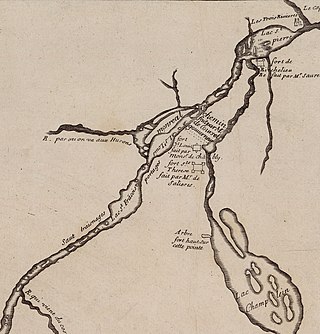
The Sainte-Thérèse Raid was a military raid on the town of Sainte-Thérèse in French Canada conducted by British elite forces known as Rogers' Rangers that took place during the French and Indian War from 3 to 18 June 1760. Led by Robert Rogers the raid was a pre-emptive strike ordered by Major General Jeffery Amherst as a prelude to his three pronged attack on Montreal the following month.
